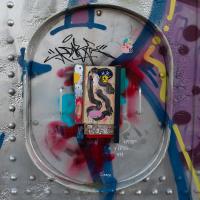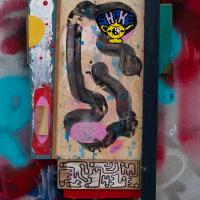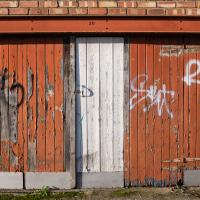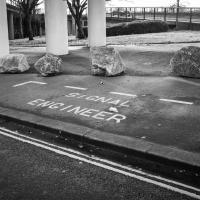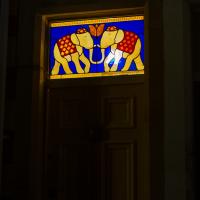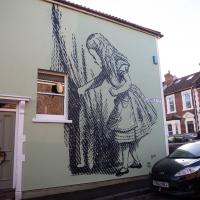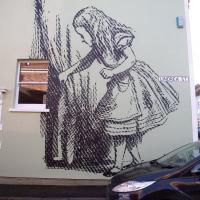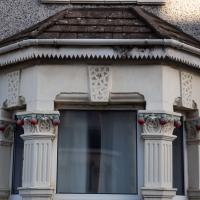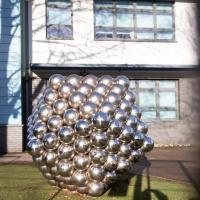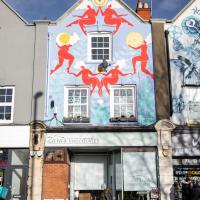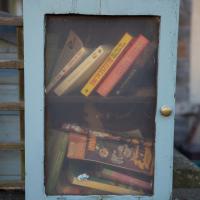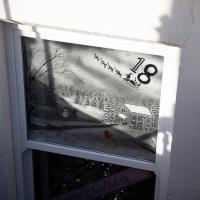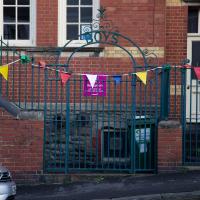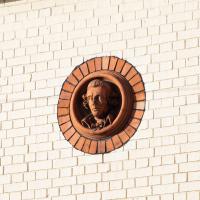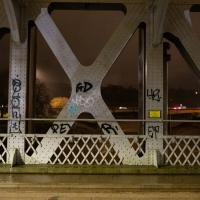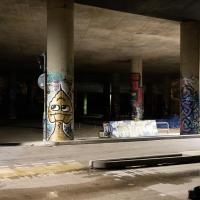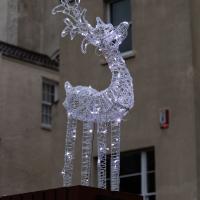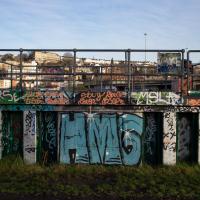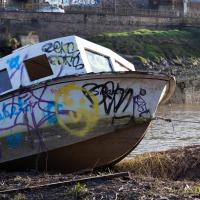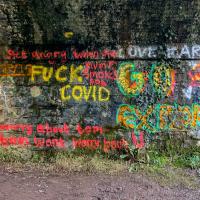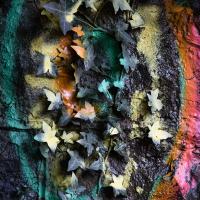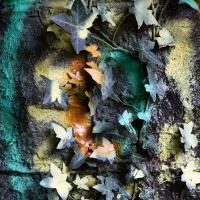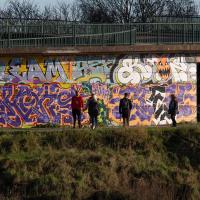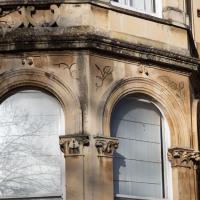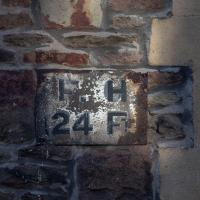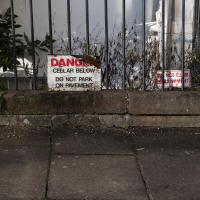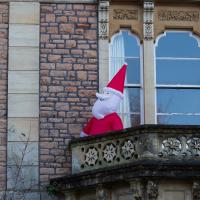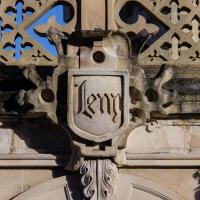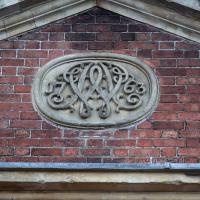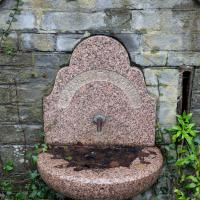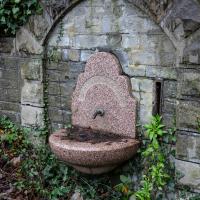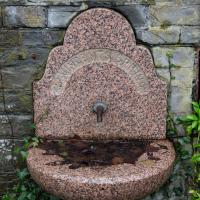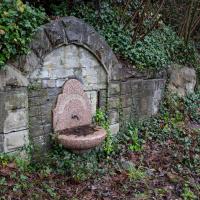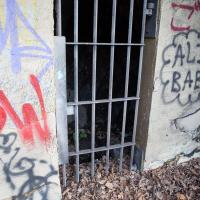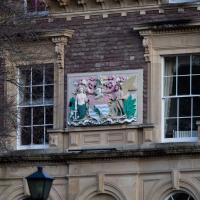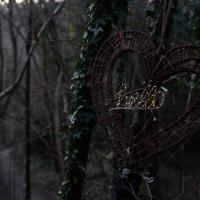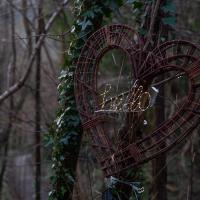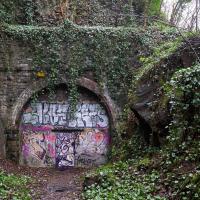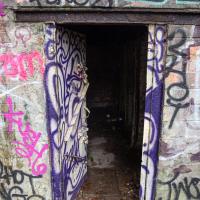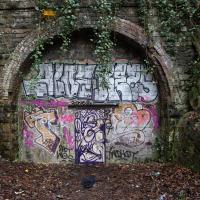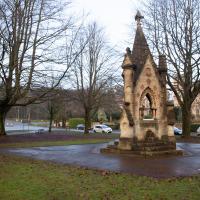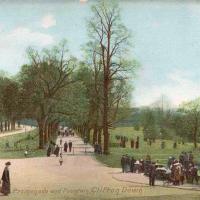Tagged: art
Drained Basin
15 Dec 2020
On the down side, I got to Bedminster and found long enough queues at both Mark's Bread and Hopper Coffee that I gave up on the idea of buying a drink and a pasty (from the former) or a mince pie flapjack (from the latter.) On the up side, I got to take some pictures of Cumberland Basin being drained and sluiced out, part of its regular maintenance cycle.
Unusually for the Ashton Avenue Bridge, this artwrok seemed to involve wooden pieces as well as just paint.
To Bedminster
19 Dec 2020
Despite a mild headache, I enjoyed this wander over to Bedminster. The light was lovely, especially toward the end. I always enjoy the view down the streets south of North Street at this time of day/year, with the distant hills backdropping the Victorian terraces.
Coming Home in the Dark
19 Dec 2020
A nice walk home in the dark early evening—we're only a couple of days away from the winter solstice—found me getting a bit lost in Southville as I tried to knock a few new streets of my list. Happily getting lost in Southville at this time of year is in no way unpleasant, and just lets you look at more Christmas lights, really.
Sunday Bedmo
20 Dec 2020
A long meander around bits of Bedminster, from the river to the north to Winterstoke Road to the south, taking a few roads I've seen before, and a few I haven't. The Christmas decorations were an extra bonus.
The original artist is John Tenniel (whose name I can never remember.) It was Stewy and homeowner Alison Larkman who did the work of putting it on the wall here, though.
Solstice Rain
21 Dec 2020
Despite the weather, Sarah and Vik and I wandered around Ashton Court a bit as the sun rose. Not that you could really tell. Sadly, the bit we wanted to watch the sunrise from was closed, because people hadn't been treating the deer with appropriate respect. Ah well, at least it was some exercise.
Sadly we couldn't take photos from the usual spots at the ends of the Suspension Bridge; it's all railinged off, presumably to stop people gathering in any significant numbers. The pedestrian footways are now also one-way, and have these signs on to remind people of the rules to keep everyone apart as much as possible.
On Christmas Day in the Morning
25 Dec 2020
A Christmas Day walk with my friends Sarah and Vik, taking in the shipwrecked Shadow and a hilly chunk of Leigh Woods.
I went to have a peep at the giant sinkhole that's opened up in Canynge Square—ironically, having recently discovered the gardens were public I'd had the (triangular!) square on my list to re-visit for a few days, but now there's no entrance to the gardens due to the danger. The area was well fenced-off for safety, but I tried to get a couple of photos from behind the barriers.
I also explored the area around Camp Road, an real melange of architectures, one of the most mixed-up areas I've seen in Clifton, in fact, and confirmed my friend Claire's suspicion that an earlier snap of a sign from Manilla Road was in fact for a fire hydrant. Nice.
Looks like it used to say "FC" rather than "FH"; from a quick google they used to be called fire "cocks" rather than "hydrants", so that might explain the change.
As a Lovecraft fan, I had of course read this as "Leng", but it's actually "Leny". LENY AND ATTACHED GATEWAY AND FRONT GARDEN WALLS AND RAILINGS
Saint Vincent's Spring
28 Dec 2020
Fractionally outside my one-mile zone, but I got curious about Saint Vincent's spring, whose last remnants you can see in a defunct drinking fountain on the Portway. Along the way I passed Gyston's cave, sometimes called St Vincent's cave, in the sheer wall of the gorge. It's now accessible by a tunnel from the observatory—I tried it about twenty years ago, I think, and still recall the vertiginous moment of looking down from the protruding balcony and realising that you could see straight through the grille floor to the drop below—but from what I can work out the tunnel is relatively recent. Before the tunnel was dug it was accessible only by access across the cliff face, which must have been even more terrifying.
This cave was first mentioned as being a chapel in the year AD 305 and excavations, in which Romano-British pottery has been found, have revealed that it has been both a holy place and a place of refuge at various times in its history.
A few different sources say that the cave became a hermitage and chapel to St Vincent following Bristol's early trading in Iberian wines; St Vincent of Saragossa is Lisbon's patron saint, and a lot of nearby things bear the name.
I'm not sure where the crossover of Vincent and Ghyston happens, though. On the giants Goram and Vincent (or Ghyston), Wikipedia says:
The name Vincent for one of the giants rests on the fact that at Clifton, at the narrowest point of the Avon Gorge, there was formerly an ancient hermitage and chapel dedicated to St Vincent, at or near the present cave in the cliff-face which bears his name. Another (apparently modern) version of the story calls the Clifton giant Ghyston, which is in fact the name, of obscure origin, for the whole of the cliff-face of the Avon Gorge at least as early as the mid-fifteenth century, in the detailed description of the Bristol area by William Worcestre. The place-name was personified to produce the giant's name. Vincent's Cave is called Ghyston cave or The Giant’s Hole in an article in the July 1837 issue of Felix Farley’s Bristol Journal.
In my research on the original Hot Well House, I've seen quite a few contemporary paintings which state their viewpoint as "from St. Vincent's Rock", so in the 16th century it seems the cliff-face name was typically St Vincent Rock rather than Ghyston's Rock, perhaps.
I am, as you can tell, no historian!
On the way, I also wandered around the base of the popular climbing area, which I think is the site of the old Black Rock quarry.
John Wesley, founder of Methodism, suffering from a "galloping consumption", found the location of St Vincent's Spring more to his taste then the main Hot Well.
Having been so close to death that he'd already written his own epitaph, Wesley tried the water from both springs (long before it was provided by anything as modern as this drinking fountain) and made a full recovery. He preferred this spring as it was further out of town, and "free from noise and hurry."
Source: Bristol Medico-Historical Society Proceedings: The West of England Medical Journal Vol 117 No 4 Article 2, The Story of the Hotwell at Bristol.
My historical research took a wander underground recently, partly inspired by the Canynge Square sinkhole, partly by St Vincent's (Ghyston's) cave and its tunnel to the Observatory, and I was surprised to find that there might be an intact tunnel from the Bristol Port Railway and Pier still just sitting there under Bridge Valley Road. A quick search turned up this recent video by an intrepid explorer, so it's definitely still there.
I went looking for the entrances today, and definitely found the south entrance, at the start of the Bridge Valley Path, the footpath that starts with steps at the bottom of Bridge Valley Road. It's easy to miss if you're not looking for it. I think I've figured out where the north entrance is, too, but it was getting dark at that stage and the Portway was still busy enough that crossing the road was still the normal nuisance, so I thought I'd leave further explorations for another day.
You can see a drawing of its better days here; "in 1946, the cast-iron pump was removed to the Underfall Yard of Bristol City Docks, and in 1961 there were reports that it had been donated to the City Museum."
Up until
A fragment from Horace's Odes: "not taught to suffer poverty."
Wikipedia says that the defunct Bristol magazine Venue once did a bit of investigative journalism on them:
Venue claimed that the Merchant Venturers control 12 charities and 40 trust funds, and also a private unlimited company, SMV Investments, that has major investments in defence contracting, tobacco, genetically modified agriculture and the petroleum industry. Merchant Venturers serve on the boards of many local charitable and cultural organisations, and are guaranteed seats on the University of Bristol Court and the Downs Committee. It quotes Paul Burton of the University's School of Policy Studies as saying, "they exert quite a bit of influence and we, the people of Bristol, don't know much about them and can't hold them to account"
To show the lights off better. It seems to have a jury-rigged battery pack and solar panel, so for all I know, it's still there, saying hello in the night...
A Promenade on New Year's Day
01 Jan 2021
I wandered along the gorge today and found the entrance to the disused Portnalls Number 1 railway tunnel of the Bristol Port Railway and Pier. The door was unlocked, but as soon as I opened it I felt a sense of current habitation and decided discretion was the best option. There's a lot of people homeless in Bristol at the moment, and they don't need disturbing. For the same reason, I've omitted posting some pictures of a little encampment somewhat off the beaten track of the new Zig Zag, where I reversed direction as soon as I realised I'd come across a current habitation of some sort.
Up in Clifton it took me a little while to work out that the picture of the Promenade I was trying to reproduce was taken from the viewpoint I'd thought, it was just that the Alderman's fountain was moved from the top of Bridge Valley Road to the other side of the promenade in 1987, so trying to use it as my initial landmark wasn't very helpful!
Finally I swung past the Society of Merchant Venturers, who presumably still own most of Clifton, having bought the entire manor, including Clifton Down, in 1676, and I imagine aren't in much danger of running out of money. That's true to their motto: indocilis pauperiem pati is apparently from the Odes of Horace, and translates as "will not learn to endure poverty"...
Oooh, it opens. However, it also looks like it closes fairly solidly and can be bolted from the outside. And it felt just a tad like there might be someone inside. So I didn't venture in.
This postcard is from somewhere between 1900 and 1920, courtesy of the Historic England archive.
This is the view I was trying to recreate -- note that the Alderman Proctor's Drinking Fountain is now on the other side of the promenade (see my photo, next), having been re-sited in 1988 after apparently causing problems for the traffic at the top of Bridge Valley Road.
